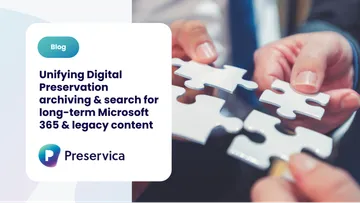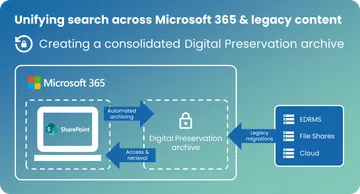Unifying Digital Preservation archiving & search for long-term Microsoft 365 & legacy content

Accelerate system decommissioning, optimize SharePoint storage & unlock the value of long-term information from Microsoft 365 & legacy systems with a consolidated Digital Preservation archive.
Executive Summary
From dark archiving to an AI ready intelligent archive embedded in Microsoft SharePoint
As organizations modernize with Microsoft 365, the challenge of managing and preserving decades of legacy and cloud content is growing. Traditional archives, built for storage, not discovery, create silos that limit access, increase costs, and block innovation.
This blog explores how a consolidated Digital Preservation archive embedded within Microsoft 365 transforms archiving from a passive compliance exercise into an active enabler of insight, governance, and long-term value.
By unifying legacy systems, SharePoint content, and preservation workflows into a single, secure environment, organizations can:
- Accelerate system decommissioning and reduce IT costs
- Standardize metadata and simplify discovery across all content sources
- Preserve integrity and ensure compliance using existing Microsoft 365 policies and permissions
- Empower users with simple self-service access to both active and archived data through familiar SharePoint interfaces
- Unlock AI-readiness, enabling trusted, discoverable information to power future analytics and intelligence
- Automate the ongoing maintenance required for archived digital files so they continually remain readable & useable in 10, 20, 30, or even a 100 years’ time
The result is a future-ready information ecosystem where archives evolve from static storage to strategic assets, turning long-term content into a driver of compliance, efficiency, and innovation.
Introduction
For decades, the concept of archiving has been largely viewed as a compliance necessity, a box to tick to ensure records are stored, retained, and recoverable. Traditional archiving meant putting data “somewhere safe”, often in static, isolated systems designed for storage rather than discovery. These archives kept information secure, but they also locked it away, making retrieval slow, search limited, value untapped and future readability not assured.
Today, however, that model is no longer sustainable. The explosion of digital content, the shift to cloud collaboration platforms like Microsoft 365, and the accelerating role of AI in enterprise data strategy have redefined what archiving must achieve. Organizations now need archives that don’t just store information, they need archives that connect, preserve, and activate it.
This evolution represents a fundamental shift: archiving is moving from a passive, back-office process to an active enabler of discovery, insight, and compliance. And nowhere is this transformation more evident than in how enterprises are rethinking information management through SharePoint and Digital Preservation within Microsoft 365.
The Hidden Cost of Siloed and Legacy Systems
Despite advancements in cloud platforms, many organizations still rely on fragmented, legacy storage environments to house long-term and historical records. Decades of accumulated data sit in a patchwork of file shares, outdated systems, and disconnected applications, often accessible only to a handful of IT staff.
This fragmentation creates several critical challenges:
- Inefficient discovery: Staff waste hours searching across multiple systems for records they need, if they can find them at all
- Metadata inconsistency: Different naming conventions, folder structures, and formats make enterprise-wide search almost impossible
- Compliance and integrity risks: Outdated systems rarely support integrity checks, meaning organizations cannot easily prove a file hasn’t been altered
- Cost and complexity: Maintaining legacy systems consumes IT budgets that could be redirected to innovation and modernization
- AI limitations: When data is siloed, it can’t be used to train or inform AI models, limiting the organization’s readiness for emerging technologies
And the challenge is growing. As more organizations adopt Microsoft 365 and SharePoint, the sheer volume of content being generated is compounding the problem. Employees are creating and sharing files faster than ever, but finding, trusting, and reusing that information is becoming increasingly difficult.
When information is siloed, it effectively becomes dark data, stored but unseen, secure but unusable. The result is reduced productivity, higher operational costs, compliance blind spots, and a significant barrier to the intelligent use of information.
The Real-World Impact: When Data Becomes a Burden
Consider a global construction firm producing terabytes of project data, including large video files, CAD drawings, and contractual documentation. Each project’s SharePoint site holds valuable information, but once projects end, those files become long-term records that still need to be retained for regulatory, legal and operational reasons.
Over time, these inactive sites bloat SharePoint storage, inflate costs, and make it harder for teams to find active materials. Meanwhile, older project data remains trapped in legacy systems and shared drives, inaccessible to most staff and nearly impossible to search effectively.
In this scenario, the very data meant to run & protect the business becomes a liability - driving cost, complexity, and inefficiency.
Introducing the Consolidated Digital Preservation Archive
The answer lies in rethinking archiving not as a static process but as an integrated, intelligent layer within the enterprise information ecosystem.
A consolidated and intelligent Digital Preservation archive, fully embedded in Microsoft 365, represents a groundbreaking step forward. It combines the best of both worlds, the compliance assurance and authenticity of digital preservation, with the discoverability and accessibility of modern collaboration tools.
By embedding preservation capabilities directly within Microsoft 365, organizations can:
- Use SharePoint as a central discovery hub, providing unified access to active, archived, and legacy content, all within a familiar interface.
- Consolidate archival records from legacy systems, file shares, and SharePoint sites into a single, secure repository.
- Standardize metadata across content sources, enabling powerful, consistent full-text search across both Microsoft 365 and historical systems.
- Preserve file integrity and readability over decades, ensuring critical information remains trusted and usable, even as technology evolves.
- Simplify compliance and governance by leveraging existing Microsoft permissions, labels, and retention policies.
This approach transforms SharePoint from a productivity platform into a centralized engine of information discovery, empowering legal, regulatory, and operational teams to quickly locate, view, and verify records without relying on IT intermediaries.
Crucially, the consolidated preservation model also allows organizations to decommission outdated systems safely, reduce storage costs, and simplify infrastructure, all while maintaining compliance and long-term access.

Simplified Security, Governance, and Scalable Adoption
Embedding a Digital Preservation archive directly within Microsoft 365 makes security and governance far easier for IT teams. Because the archive leverages existing Microsoft 365 permissions, labels, and policies, organizations can enforce access controls consistently across archived and active content, ensuring sensitive information is protected while maintaining regulatory compliance.
For end users, adoption is smoother because the archive integrates seamlessly with familiar SharePoint interfaces. Staff can search, view, and interact with archived content without learning new tools or workflows, reducing friction and supporting self-service access across departments.
Scalability is another key advantage. The solution can be deployed across multiple SharePoint sites and even multiple tenants, enabling organizations to consolidate long-term content across complex, distributed environments. Whether managing a single business unit or a global enterprise, the embedded archive provides centralized control, consistent governance, and seamless access, all while scaling to meet growing volumes of data without adding operational complexity.
In short, embedding preservation within Microsoft 365 turns long-term content from a management challenge into a secure, governed, user-friendly, and scalable asset.
From Compliance to Insight: Building a Future-Ready Information Strategy
By consolidating long-term records into an embedded, trusted archive within Microsoft 365, organizations create a bridge between the past and the future. They gain a single, authoritative view of their information, reduce operational risk, and unlock the data foundation needed for AI-driven insights.
After all, AI cannot analyze or reason over data it can’t access or trust. Preserving the integrity, usability, and discoverability of your long-term information isn’t just a compliance exercise, it’s a strategic investment in future intelligence.
In short, this evolution represents a new era of information governance: one where archives are no longer silent repositories but living assets that drive compliance, efficiency, and innovation.
Conclusion
Turning Information from a Liability into a Strategic Asset
Digital archiving has evolved from static, compliance-driven storage to dynamic preservation that enables discovery and insight. Many organizations still struggle with siloed systems, legacy applications, and sprawling SharePoint content, creating dark data, slowing operations, and increasing compliance and IT costs. With Microsoft 365 and AI workflows becoming central to business, having accessible, trusted, and well-governed information is now strategic.
A consolidated Digital Preservation archive embedded in Microsoft 365 addresses these challenges by centralizing archival content, standardizing metadata, and providing secure, controlled access. This enables organizations to:
- Break down silos and make information discoverable
- Support faster, smarter decision-making across legal, regulatory, and operational processes
- Reduce storage, IT complexity, and risk from legacy systems
- Unlock long-term data value for compliance, insights, and AI-driven innovation
By transforming SharePoint into a central hub for unified content discovery, organizations can future-proof their information ecosystem, empower teams with actionable insights, and fully leverage AI capabilities. The future of archiving is no longer passive, it’s active, integrated, and a true driver of business value.
Quick Summary
A consolidated Digital Preservation archive embedded in Microsoft 365 enables organizations to:
- Break down silos and eliminate “dark data.”
- Streamline access and discovery across all information sources
- Reduce risk, complexity, and storage costs
- Strengthen compliance and governance
- Build a trusted, AI-ready foundation for the future
The days of passive archiving are over. The future belongs to active preservation, where every piece of information is not only protected but ready to deliver value whenever it’s needed most.
Learn more:




